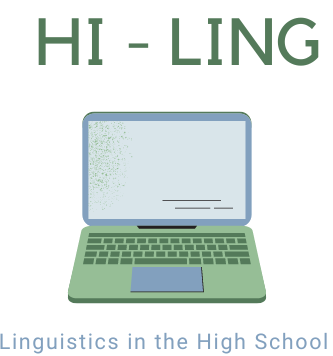HI-LING
LINGUISTICS IN THE HIGH SCHOOL

UNIT 2: VIOLATION OF MAXIMS
Introduction to language documentation
Through this introduction, you will have an overall idea about what language documentation involves. This knowledge will open you the doors to a deeper exploration of the subfields that constitute language documentation.
I. Everyone knows about endangered animals…
We all know that many animal species on our planet are at risk. Take a moment to think about species you know that are threatened. Which ones come to mind?
The diversity of species like birds or insects are, in particular, in danger. The amount of birds on Earth is decreasing so rapidly, that one out of every eight species is on the verge of disappearing. Organizations such as WWF and Greenpeace are working hard to protect these animals and maintain biodiversity.
Would you guess that the same phenomena of threat also exists for languages? Can you think of any endangered languages?
Some languages are endangered because fewer and fewer people speak them. Some are even considered dead! This is because they're no longer spoken, at all. So, is there an entity fighting to preserve languages which is similar to the ones that work to protect animal diversity? Yes, there is, and it’s called language documentation! Keep reading to learn more about what these people do and what language documentation is all about.

…but what about endangered languages?
II. What is Language Documentation exactly?
Language documentation or documentary linguistics is a worldwide approach to studying languages that emerged in 1995. Linguists have embarked on this journey to document various languages because many of them, which are still spoken today, are at risk of disappearing. Language documentation aims to create a comprehensive record of a language through a corpus of primary data that leaves nothing out, so that later generations can explore any aspect of the language they are interested in.
The idea behind this is to create an organized and multipurpose collection of real-life examples showing how a language is actually used in different cultural and social situations. These examples contain everyday conversations, narratives or prayers for example, coming from various speakers.

III. Why do we need language documentation?
Have you ever thought about why we should save languages? Is it a big deal? Well, language preservation isn’t just about understanding how a language works, but also about how it's linked to the people who use it and their identity. If you think about what a language is and why it's important to keep it alive, you will realize that it's not just a way to talk to each other. It's also a way to express the culture and the beliefs of the people who speak it. Languages can reveal to us a lot more about a community and its people than you might first imagine.
Now, from a linguistic perspective, studying languages means carefully looking at how different groups of people talk. It's sad to think that many languages that are still spoken currently could disappear in the future. Do you think Romance languages, like Romansh in Switzerland, could be an example of this? There are still some people who speak Romansh, but they make up a small part of the population. It's likely that Romansh might vanish in the next few decades, making it an endangered language. But here's the good news: thanks to the study of languages, we can capture how Romansh sounds, learn about the people who speak it, and understand their unique way of talking.
Language is a reflection of our essence, and it is through language that we can achieve and build global connections.

You’ve just acquired the basics in language documentation. Dive into the following lessons to find out much more about this fascinating topic!
References:
Austin, Peter K. (2021). Language Documentation and Language Revitalization. In: Olko, Sallabank (Ed.): Revitalizing Endangered Languages: A Practical Guide. (pp. 199 - 219). Cambridge, UK:Cambridge University Press.
BirdLife.ch (2022, September 29): Bericht "State of the World's Birds 2022". Zahl der Vögel nimmt rapide ab. Retrieved from
Field Notes (2022): Episode 36: Quechua Language Documentation & Revitalization with Gladys Camacho Ríos.
https://fieldnotespod.com/2022/03/31/episode-36-quechuan-language-documentation-revitalization-with-gladys-camacho-rios/. (28.10.2023).
Himmelmann, Nikolaus P. (2006). Language documentation: What is it and what is it good for? In: J. Gippert, N. P. Himmelmann, U. Mosel (Eds.): Essentials of Language Documentation. (pp. 1 - 30). Berlin, New York: de Gruyter.
Nachhaltigleben.ch: Naturnahe Wild- und Tierparks in der Schweiz [Photograph].
https://www.nachhaltigleben.ch/ausfluege/tierparks-schweiz-wildpark-und-gibt-es-dort-artgerechte-tierhaltung-3008. ( 28.10.2023)
Shibata, M. (2021). L2 English Speakers’ Perception of their English Accent: An Investigation of European and Asian Attitudes. English Language Teaching, 14, 126-143. https://doi.org/10.5539/elt.v14n12p126
Salminen, T. (2007). Endangered Languages in Europe. In W. Walter, H. H. Hans, W. Werner (Eds.) Language Diversity Endangered. (pp. 205-232). Berlin, New York: Mouton de Gruyter. https://doi.org/10.1515/9783110197129.205
Pixabay. com (2020, November 1). Street [Photograph]. https://pixabay.com/es/photos/calle-la-carretera-gente-multitud-5703332/ (14.11.2023)
Pixabay.com (2018, February 11). Manuscript [Photograph].
https://pixabay.com/es/photos/global-mapa-geograf%C3%ADa-viaje-2566114/ (14.11.2023)